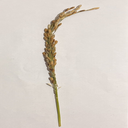Search
About Oryza sativa (Xian/Indica-2B var. Larha Mugad)
Asian cultivated rice is a staple food for half of the world population. With a genome size of ~390 Mb (n=12), rice has the smallest genome among the domesticated cereals, making it particularly amenable to genomic studies. In 2020, a reanalysis of the population structure analysis showed that rice could be subdivided into a total of 15 subpopulations (XI-1A, XI-1B1, XI-1B2, XI-2B, XI-2A, XI-3B1, XI-3A, XI-3B2, GJ-trop1, GJ-trop2, GJ-subtrp, GJ-tmp, cA2, cA1 and cB) and 4 admixed populations (GJ-adm, XI-adm, admixed and cA-adm). Then 16 rice cultivar varieties were selected based on genetic diversity and origin that could represent the 15 subpopulations and the largest admixed population, i.e. XI-adm. The collection of 16 Platinum Standard RefSeqs (PSRefSeq) can be used as a template to detect virtually all standing natural variation that exists in the pan-genome of cultivated Asian rice. Oryza sativa cv. IRGC 125619 (variety cv. LARHA_MUGAD::IRGC_52339-1) (collected from India) is selected as the representative of XI-2B subpopulation, in which the accessions are mostly collected from India and Madagascar.
Notes for subpopulations: cA = circum-Aus; cB = circum-Basmati; GJ= Geng-japonica where trop = tropical, subtrp = subtropical; XI = Xian-indica
More information can be found on the IRRI website.
Picture credit: Keerthana Manickam, Rod Wing, Yong Zhou, KAUST, 2023.
Taxonomy ID 39946
Data source University of Arizona
Comparative genomics
What can I find? Homologues, gene trees, and whole genome alignments across multiple species.
 More about comparative analyses
More about comparative analyses
 Phylogenetic overview of gene families
Phylogenetic overview of gene families
 Download alignments (EMF)
Download alignments (EMF)
Variation
This species currently has no variation database. However you can process your own variants using the Variant Effect Predictor:






 Display your data in Ensembl Plants
Display your data in Ensembl Plants

 Update your old Ensembl IDs
Update your old Ensembl IDs

![Follow us on Twitter! [twitter logo]](/i/twitter.png)
